Top News
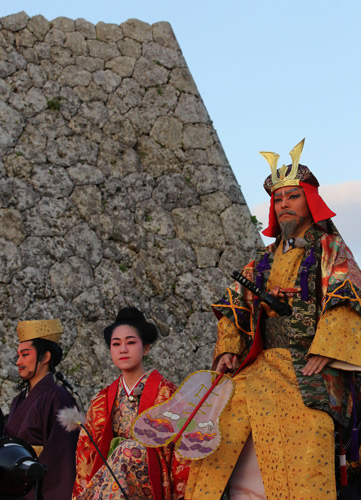
December 27, 2014 Ryukyu Shimpo
In the early morning on December 21, people gathered to worship the rising sun of the winter solstice at the ruins of Nakagusuku Castle. Many villagers from Nakagusuku and Kitanakagusuku took part in the ceremony to pray for good health and development of the communities. It is a legend of old that the sun is reborn on the day of the winter. Carrying on this tradition, the gathering is held every year on the holiday before and after the winter solstice.
At the gathering, a play called “An Oath at a Wedding Ceremony,” in which a couple swears their marriage to Gasamaru, the owner of Nakagusuku Castle, was performed. Mitsue Nakamura, a member of the Nakagusuku Village Cultural Association, wrote the screenplay of the drama.
Members of the cultural associations of both villages performed Ryukyuan Classic music. Many people came to enjoy the ceremony and event.
(English translation by T&CT)
Go to Japanese
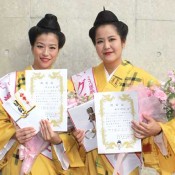
December 24, 2014 Ryukyu Shimpo
On December 21 at Onna Village Community Experience and Learning Center, the new “Miss Onna Nabi,” a role designed for the promotion of tourism in Onna Village, was held. Twenty-nine year-old Ayaka Yokota won the Grand Prix and 33-year-old Ayae Iha won the semi-Grand Prix. Kenichi Toyama, president of the Onna Village Chamber of Commerce and Industry, presented certificates and commemorative gifts to them.
Their term in the tourism promotion role starts on January 1 and goes for two years. They will promote Onna village at public events and exchange programs with other communities.
Yokota, who has previously performed dance and sanshin at tourist facilities, said, “I would like to learn more about promoting the features of Onna Village such as culture and tradition. I look forward to the two-year role.” Iha, who is originally from Saga Prefecture, said with a smile, “I would like to promote the appealing points of Onna from other communities’ views.”
The competition was one of events at the 17th Village Industry Festival held on December 20th and 21st. There was also a booth with local specialty products and a “manufacturing experience” booth where visitors could paint shisa and do plant dyeing. The venue was crowded with families.
(English translation by T&CT and Megumi Chibana)
Go to Japanese
December 25, 2014 Ryukyu Shimpo
On December 24 Okinawa Prefectural Assembly passed a resolution and written opinion asking for the cancellation of construction of a new US base in Henoko, Nago. They were passed with a majority made up of the ruling party and Komei party members. The resolution and written opinion were submitted by the ruling party. The governments of Japan and the United States are carrying out construction work as part of a relocation of U.S. Marine Corps Futenma Air Station in Ginowan to Henoko.
Referring to the results of the gubernatorial race and the House of Representatives election, in which all candidates opposing the construction of new U.S. base won, the resolution says that public opinion against the construction is overwhelming and firm. It asked the governments of Japan and the United States to abandon the relocation project, and it called for the removal and closure of the Futenma base.
A written opinion seeking early closure and return of U.S Futenma Air Station submitted by the Liberal-Democratic Party failed to win enough votes parliament and was rejected.
The Liberal-Democratic Party’s proposal stated that the governments should solve the issue, accepting the reality of the results of the gubernatorial election and the election of the House of Representatives. It does not mention the relocation site. Members of the Liberal-Democratic Party, Hiroshi Goya (Political Group of Okinawa Revolution) and Hikaru Minei (independent) favored it over the proposal of the ruling party, which specifically opposes the Henoko relocation. Toma, Gima and Arakaki walked out of the voting on the Liberal-Democratic Party proposal.
Morio Toma, Mitsuhide GIma (Political Group of Okinawa Revolution) and Yasuhiro Arakaki (independent) supported the written opinion seeking to abandon the new base in Henoko. Members of the assembly will visit Tokyo to hand the resolution and written opinion directly to the officials of relevant agencies.
The assembly unanimously adopted a resolution demanding strict discipline among U.S. service members and its civilian employees, including cancellation of the easing of an off-duty action guideline or ‘liberty policy’ for the service members. Since the policy was eased incidents involving U.S service members have already taken place.
In addition to these resolutions, the assembly has unanimously passed the general supplementary budget submitted by Governor Takeshi Onaga .
(English translation by T&CT)
Go to Japanese
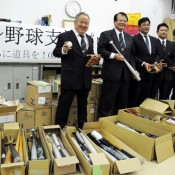
December 23, 204 Ryukyu Shimpo
Taku Uehara, teacher of Gushikawa Commercial High School, is promoting baseball in Zanzibar, Tanzania. To support Uehara, Okinawa branch of the Japan High School Baseball Federation will send baseball gear collected from the member schools and individuals, to the country. On December 22, at its office in Futenma High School, the organization showcased to the media the gear soon to be sent to Tanzania. The organizers expressed their appreciation for the support.
By setting up the Zanzibar Baseball Federation, Uehara has worked extensively on promoting the sport, which is not a major sport on the East African island. With shortage of gear to send to Zanzibar, Uehara asked the organization to help his project. From the middle of December, the organization asked for nationwide support in promoting baseball in Zanzibar, sending request papers to its member schools and publishing advertisements in baseball magazines.
The organization has received about 60 baseball bats, about 70 gloves, and about 1,300 balls from 19 schools in Okinawa and individuals. The head of the organization Takashi Kamiya said, “We hope this project will help enrich young people and promote baseball on the island. It is important for Okinawan children to contribute to the international community.”
The gear will be packaged and then brought to Kobe Port under the support of distribution company Sankyu, Inc. The gear will then be sent to Tanzania with support of companies in Osaka.
(English translation by T&CT)
Go to Japanese
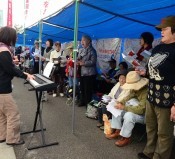
December 25, 2014 Ryukyu Shimpo
The governments of Japan and the United States plan to build a new offshore air base in Henoko, Nago as a replacement for U.S. Marine Corps Air Station Futenma. On the morning of December 25, about 100 citizens gathered and staged a sit-in protest against the plan in front of the gate of U.S Marine Camp Schwab in Henoko.
For Christmas, members of the Gospel Singers Association Against U.S bases in Okinawa visited the sit-in protesters. They sang gospel songs to oppose the construction of the new base and prayed for peace.
The head of the association Takehiro Kamiya said, “The U.S and Japanese governments are oppressing Okinawa. Now is the time to transcend religions and unite with many people through music.” The association members plan to sing gospel in front of the Camp Schwab gate every fourth Friday from next January.
Moriteru Arasaki, professor emeritus at Okinawa University, took part in the protest. Arasaki said, “The Okinawan civil movement has reached a new point. The foundation of a right to self-determination is a right to resist. Each of us should do what we can do. That will lead us to a constructive future.”
Before noon, it was confirmed that underwater research activities by the Okinawa Defense Bureau were not taking place off the coast of Camp Schwab.
(English translation by T&CT)
Go to Japanese
December 17, 2014 Ryukyu Shimpo
On December 16, Higashi Village Mayor Seikyu Iju said at the village assembly, “I have strongly requested that Okinawa Defense Bureau not let its construction trucks go through the village. I will block them physically.” The defense bureau plans to construct a U.S. helipad at G area within the Northern Training Area (NTA) near Takae, by the end of the fiscal year on March 31.
The government of Japan is carrying out a relocation of base facilities, which includes building helipads, within the NTA, to return a part of the training area to landowners based on an agreement between Japan and the United States. However, the mayor repeated his position that he would accept the construction work for the helipad.
An assembly member asked that all of the NTA be returned, suggesting there was a growing movement to have the Yambaru forest registered, including the NTA, as a World Natural Heritage site. The mayor answered, “I think it is better to get over half of the area returned and step-by-step for the rest of the area.”
(English translation by T&CT, Hitomi Shinzato)
Go to Japanese
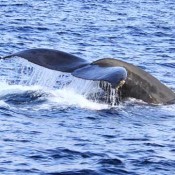
December 24, 2014 Hirokazu Otsubo correspondent of Ryukyu Shimpo
On December 23, a humpback whale was sighted swimming in waters about 6 km northwest of Zamami Island. While the whale swam slowly, it occasionally slammed the surface of the water with its tail fin and splashed the water.
At 1:20 p.m. on December 23, a staff member of the Zamami Village Whale Watching Association spotted a whale from an observatory post on the island. The staff member, riding a boat, pursued the whale. The whale repeatedly dived into and then emerged from the water.
According to the association, fishermen witnessed two whales in the waters near Zamami Island on December 27. This season’s whale watching will start on December 27 and will end on April 5 next year.
(English translation by T&CT)
Go to Japanese
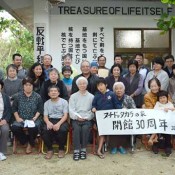
December 17, 2014 Hiroe Nakagawa, Correspondent of Ryukyu Shimpo
On December 8, the Anti-War Peace Museum in Higashiemae, Ie Village “Nuchi-du-Takara-no-Ie,” celebrated the 30th anniversary of its opening. The museum marked the occasion by holding a screening of video records and presenting a collection of testimonials. The museum is owned by the Wabiai no Sato Foundation. About 35 people from in and outside the village gathered. The group has been examining large amounts of material left by the late Shoko Ahagon and related parties that were involved in opening the museum. They looked back on the past 30 years of activities.
The Anti-War Peace Museum opened when Shoko Ahagon was 83 years old. Ahagon had his land forcibly taken by the American military’s weapons and bulldozers, and dedicated his life to peace activism. The museum houses collections of wartime artefacts and records, photos, and newspaper articles of the village’s struggle against the forced takeover of land. Many people, such as peace study students on study trips, have visited the museum.
The event started at 2 p.m., which was the same time the opening ceremony of the museum took place 30 years ago. Inside the Wabiai no Sato building, photos from the museum’s construction and its completion ceremony were exhibited. An archived video of Ahagon explaining the various museum exhibits was also screened.
In the video showing the museum’s opening ceremony, a clip of Ahagon speaking about his hopes for peace and explaining the origin of the museum’s name, which means “Life is the greatest treasure,” was played. After the screening, attendees spoke about the time when the museum was opened. There were also anguished recollections from the attendees who were wartime survivors. Museum director Etsuko Jahana greeted the attendees, saying, “Let us work together to eliminate the man-made calamity known as war.”
(English translation by T&CT and Lima Tokumori)
Go to Japanese
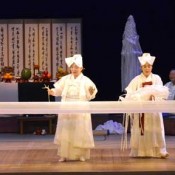
December 17, 2014 Ryukyu Shimpo
The National Theater Okinawa held its 10th anniversary special performance “Sacred Songs from Miyako and Chindo Ssit-kkim-gut from Korea” and introduced contrasting folk cultures. While Miyako’s sacred songs are simply performed only with songs, performers of Ssit-kkim-gut play instruments loudly to arouse emotions.
The joint performance was made possible after the Theater invited Tsukasanma, women who administer Okinawan traditional rituals, from Sarahama of Irabu Island, to participate in an inspection trip at the International Symposium on Safeguarding Asian Shaman Heritage, which was held last November in South Korea.

<em>Tsukasanma</em> sing sacred songs
Former Tsukasanma, Chiyomi Yogi, Kunie Nagasaki, and Toshimi Uehara performed at the 10th anniversary performance. They sang a special song “Oyoshi” to communicate with spirits. Usually, ordinary people are not allowed to listen to the song. They continued with “Oyoshi Nanamui,” a song to worship the god of Nanamui(Uharuzu Utaki), and “Oyoshi Maukan,” a guardian song for traveling. The performance brought a sacred mood to the audience.
Ssit-kkim-gut is a ceremony to send off the spirits of the dead. Song Soon-dan, Park Mi-ok, Gang Eun-young, and Song Young-in, who are traditional Korean priestesses called Tanggol, together with eight other musicians performed. Using traditional instruments such as a roped drum called Janggu and a string instrument called Ajaeng, performers presented moving Tangool songs and captivated the audience. Performances included “Kopuri,” which is a ritual to disconnect the spirit of the dead by undoing a knot of white cloth, and “Gil-tag-kum,” in which performers act out sending the dead on a boat called Banya-yongseon, symbolizing the passage to the afterlife.
(English translation by T&CT and Megumi Chibana)
Go to Japanese
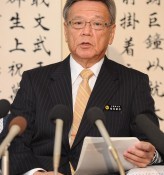
December 22, 2014 Ryukyu Shimpo
Okinawa Governor Takeshi Onaga gave an interview to media outlets at the Okinawa Prefectural Government (OPG) Office building on December 22. Onaga said he would set up a team to look into the Henoko landfill approval by former Governor Hirokazu Nakaima. The team will be set up by the middle of January at the latest.
He also said, “I would like to visit the United States after April because we will be busy before and after the February regular meeting, in which we will discuss the budget bill for the fiscal year of 2015.” He went on to say, “I would like swiftly to allocate an OPG official to reside in Washington. It is important to collect information and analyze it to make visiting the United States effective.”
Onaga said, “I would like to visit Tokyo to meet the ministers related to Okinawa affairs including Prime Minister Shinzo Abe on December 25 and 26.” He continued, “I intend to inform them of Okinawan people’s will to oppose the construction of a new U.S.military base in Henoko.”
(English translation by T&CT)
Go to Japanese
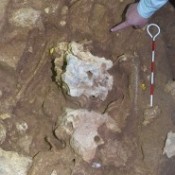
December 11, 2014 Ryukyu Shimpo
On December 11, an official from the Okinawa Prefectural Museum and Art museum announced that they had found human bones dating back over 9,000 years at Sakitari Cave, located in the Valley of Gangala, Maekawa in Tamagusuku, Nanjo.
The bones were found with the head and upper body connected together. According to an official of the museum, the bones were possibly put into the land as burial. He said, “This indicates the possibility that people at that time used to use caves as graves.” In Okinawa, this is the first and oldest specimen of a connected skeleton found in its original position and not relocated.
Bones from one adult individual were discovered, with mainly upper-body parts such as the skull and arms, as well as the femur and pelvis. The bones were dug from about three meters beneath an excavation site near the entrance of Sakitari Cave. The bones were found in a posture lying flat and facing up, covered by four pieces of limestone about 30 centimeters in diameter, which suggests this was a deliberate burial.
While prehistoric human bones from the Paleolithic era, about 20,000 years ago, like the Minatogawa Man and the Shiraho Saonetabaru Cavemen, have previously been discovered in Okinawa, this is the first time a specimen with a connected skeleton has been found.
(English translation by T&CT and Lima Tokumori)
Go to Japanese










 Webcam(Kokusai Street)
Webcam(Kokusai Street)


